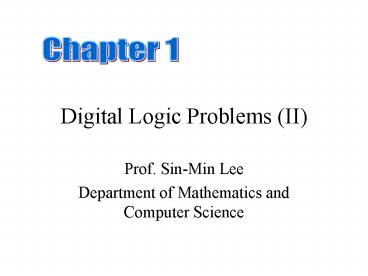Digital Logic Problems II - PowerPoint PPT Presentation
1 / 30
Title:
Digital Logic Problems II
Description:
Digital Logic Problems (II) Prof. Sin-Min Lee. Department of Mathematics and Computer Science ... A combinational circuit that selects info from one of many ... – PowerPoint PPT presentation
Number of Views:52
Avg rating:3.0/5.0
Title: Digital Logic Problems II
1
Digital Logic Problems (II)
Chapter 1
- Prof. Sin-Min Lee
- Department of Mathematics and Computer Science
2
(No Transcript)
3
(No Transcript)
4
(No Transcript)
5
(No Transcript)
6
(No Transcript)
7
(No Transcript)
8
(No Transcript)
9
(No Transcript)
10
Multiplexers
- A combinational circuit that selects info from
one of many input lines and directs it to the
output line. - The selection of the input line is controlled by
input variables called selection inputs. - They are commonly abbreviated as MUX.
11
Implementing Boolean functions with multiplexers
- Any Boolean function of n variables can be
implemented with 2n-1-to-1 multiplexer. The
procedure for implementing a Boolean function
with a multiplexer is - 1.Express the function in its sum of minterms
form. - 2. Order the sequence of variables chosen for the
minterms. Suppose the sequence is , where A is
the leftmost variable, and are the remaining
n-1 variables.
12
- 3.Connect the n-1 variables to the selection
lines of the 2n-1-to-1 multiplexer, with B
connected to the highest order selection line,
and so on. - 4. Construct the implementation table List all
the minterms in two rows. - The first row consists of minterms 0 to 2n-1 -1
(in all of which A is complemented). - The second row consists of minterms 2n-1 to 2n-1
(in all of which A is uncomplemented). .
13
- 5. Circle all the minterms of the function and
inspect each column in the implementation table
separately - If the two minterms in a column are not circled,
apply 0 to the corresponding multiplexer input. - If the two minterms are circled, apply 1 to the
corresponding multiplexer input. - If the bottom minterm is circled, and the top is
not circled, apply A to the corresponding
multiplexer input. - If the top minterm is circled but not the bottom,
apply A
14
(No Transcript)
15
- Multiplexers and decoders are used when many
lines of information are being gated and passed
from one part of a circuit to another. - Multiplexing is when multiple data signals share
a common propagation path. Time multiplexing is
when different signals travel along the same wire
but at different times. These devices have data
and address lines, and usually include an
enable/ disable input. When the device is
disabled the output is locked into some
particular state and is not effected by the
inputs.
16
(No Transcript)
17
(No Transcript)
18
Consider the function of 3 variables
1. Input variables B and C are applied to the
selection lines s1 and s0, respectively. 2.
Construct the implementation table, and circle
all the minterms of the function in the
implementation table
3. Apply 0, 1, A, and A to the inputs I0
through I3.
19
Multiplexers (continued)
- S0 and S1 are the selection inputs.
- D0, D1, D2, D3 are the input lines.
20
Multiplexers (continued)
- MUX blocks can be combined in parallel with
common selection and enable inputs to perform
selection on multiple bit quantities.
21
Combinational circuit implementation using MUX
- We can use Multiplexers to express Boolean
functions also. - Expressing Boolean functions as MUXs is more
efficient than as decoders. - First n-1 variables of the function used as
selection inputs last variable used as data
inputs. - If last variable is called Z, then each data
input has to be Z, Z, 0, or 1.
22
(No Transcript)
23
(No Transcript)
24
(No Transcript)
25
(No Transcript)
26
Karnaugh Map Method of Multiplexer Implementation
Consider the function
A is taken to be the data variable and B,C to be
the select variables.
27
Example of MUX combo circuit
- F(X,Y,Z) Sm(1,2,6,7)
28
(No Transcript)
29
Implement g(w,x,y)wxxywy using a 4-1
multiplexer.
30
(No Transcript)































